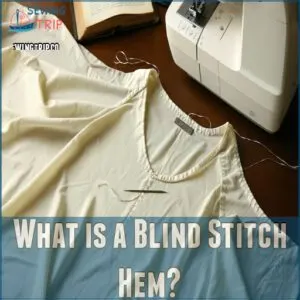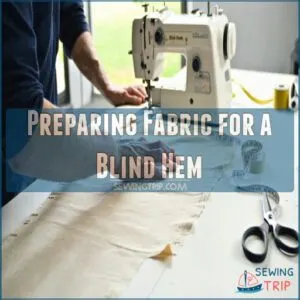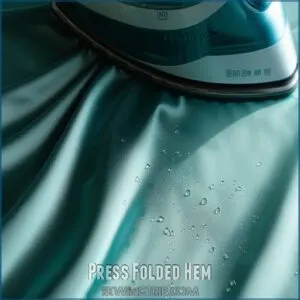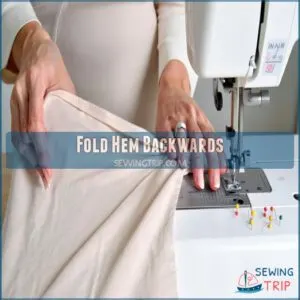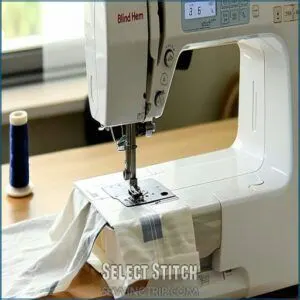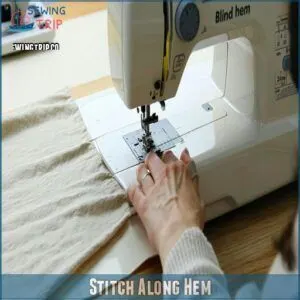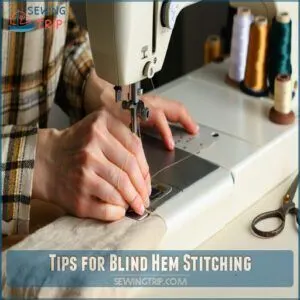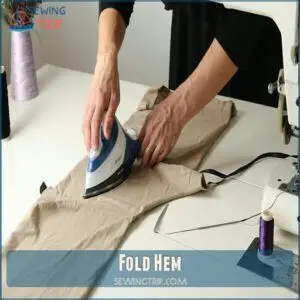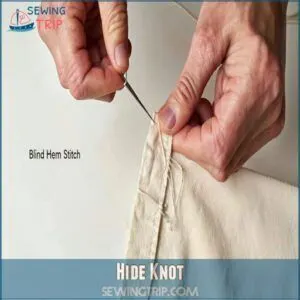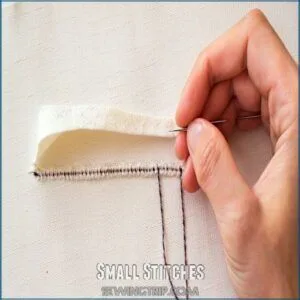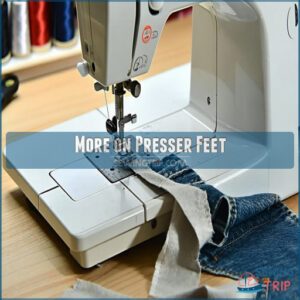This site is supported by our readers. We may earn a commission, at no cost to you, if you purchase through links.
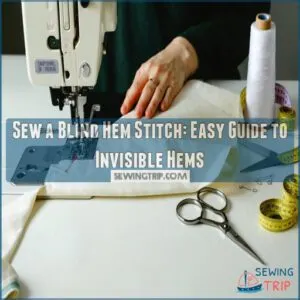 To sew a blind hem stitch, start by folding your hem to the desired length and pressing it for a sharp crease.
To sew a blind hem stitch, start by folding your hem to the desired length and pressing it for a sharp crease.
Then, fold the hem back so about 1/8 inch of the fabric’s edge is exposed.
If you’re using a sewing machine, attach the blind hem foot, select the blind hem stitch setting, and adjust the stitch width to match your fabric.
Slowly sew along the fold, keeping even tension.
By hand? Use small, spaced stitches, hiding the knot inside the fold.
Either way, the result is an elegant, invisible finish—perfect for pants, dresses, or any polished look.
Table Of Contents
Key Takeaways
- Fold and press your hem carefully, creating a sharp crease to guide your stitches and ensure clean results.
- Use a blind hem stitch on your sewing machine with the correct settings and presser foot for a nearly invisible finish.
- Hand-sew small, spaced stitches, hiding the knot within the fabric fold, for delicate fabrics or added control.
- Match your thread color to the fabric and practice on scraps to refine your technique for seamless hems.
What is a Blind Stitch Hem?
A blind stitch hem is a technique used to create an invisible finish on delicate fabrics. It’s a variation of the backstitch, and precision is key to mastering this skill.
When to Use
You’ve got a secret weapon for achieving that sleek, seamless look: a blind stitch hem.
It’s your ace up your sleeve for creating high-end, invisible finishes on dresses, skirts, and pants.
This technique is a pro move when you’re working with medium-weight fabrics and want a crisp, polished edge.
It’s the go-to for straight hems that hang free, letting the fabric flow naturally without a stitch in sight.
Here’s when to go for it:
- You’re after an invisible finish for a sleek, seamless look.
- Your fabric choice is medium-weight, and you want a clean edge.
- You need a straight hem that hangs freely, allowing the fabric to drape without visible stitching.
Vs Ladder Stitch
When choosing between stitch styles, the blind hem and ladder stitch techniques stand out for unique reasons.
The blind hem stitch, a pro move, needs a sewing machine and special foot, creating near-invisible seams on medium-to-heavy fabrics with deep hems.
It’s perfect for a polished look on pants, skirts, and dresses.
On the flip side, the ladder stitch is your delicate dance partner for lightweight, fragile fabrics.
This hand-stitched method uses tiny, precise stitches to create an invisible finish, ideal for fine details and fabrics that can’t handle machine stitching.
Two distinct methods, each with their own shine.
Preparing Fabric for a Blind Hem
Before you start stitching, it’s important to prepare your fabric.
You’ll need to adjust the length of your fabric to the desired hem length and press the edge to create a crisp, neat fold.
Adjusting Length
Getting the perfect hem length is an art, and it’s vital to get it right the first time.
You don’t want to be fiddling with wonky hems and unraveling threads later.
So, here’s the lowdown: Measure twice, and mark your desired length.
For a blind hem, you’ll need a little extra fabric—about an inch for hand sewing, and a smidge more for machine stitching.
Test your stitch width on a scrap of fabric first.
This guarantees you catch just enough fabric without those pesky visible stitches on the right side.
Heavier fabrics like wool require wider allowances than lighter cottons.
So, factor in fabric weight, and you’ll have stitch control and a flawless finish.
Mastering the invisible hem stitch is essential for achieving professional-looking results with every garment.
Pressing Edge
Before tackling a blind hem stitch, proper edge pressing is key to achieving those invisible results we all aim for.
Here’s a simple four-step process:
- Turn up that raw edge—a quarter-inch for lightweight fabrics. For bulkier materials, serge or zigzag to prevent fraying.
- Crank up the steam on your iron. This helps create crisp, pro-level folds that glide smoothly through your machine.
- Zigzag bulkier fabrics to avoid bunching under your presser foot.
- Adjust seam allowances before pressing, and keep your fabric flat for even heat distribution.
Using the right sewing irons tools can make a significant difference in the quality of your blind hem. Get this part right, and you’re already halfway to a flawless blind hem.
How to Sew a Blind Hem by Machine
Using a sewing machine for a blind hem saves time and creates a polished, nearly invisible finish.
With the right setup and a few adjustments, you’ll master this technique in no time!
Press Folded Hem
A crisp fold is your secret weapon for flawless folded hem techniques in blind hemming.
With your iron set to the right temperature for the fabric, press along the folded edge firmly but steadily.
This step creates a sharp crease that acts like your stitching road map.
For delicate fabrics, place a press cloth on top to avoid shiny spots.
Add light steam if needed for stubborn creases.
| Fabric Type | Iron Setting | Extra Tip |
|---|---|---|
| Cotton | High | Use light steam |
| Silk | Low | Use a press cloth |
| Wool | Medium | Steam without overpressing |
Fold Hem Backwards
Here’s where the blind hem stitch gets interesting.
Take your pressed hem and fold it backwards, leaving just about 1/8 inch (3mm) of fabric sticking out.
This little lip is key to hemming fabric invisibly.
Keep everything smooth—no puckers allowed!
Pin it, check your fold precision, and make certain the seam allowance stays tidy.
Fabric tucking here sets you up perfectly for edge finishing with an invisible stitch.
Mastering the blind hem technique is vital for achieving professional-looking results.
Select Stitch
Setting up your sewing machine is simple once your hem is folded.
Look for the blind hem stitch setting—it’s the one with straight stitches dotted by zigzags for that perfect invisible stitch.
Test the waters with your settings on scrap fabric first!
Adjust for your fabric type:
- Stitch length: 2-3 for smooth stitches.
- Stitch width: Narrow for delicate fabrics, wider for thick ones.
- Tension settings: Keep everything balanced for clean results.
To achieve professional results, understanding the blind stitch machine is vital for mastering invisible hems.
Pick a thread color that blends in.
Don’t rush—slow your sewing speed for precision.
Stitch Along Hem
Sewing along the hem is where the magic of the invisible hem stitch happens.
Keep the folded edge tight against the stitch guide while maintaining the fabric tension stays even.
Use a slow, steady pace—blind hemming rewards patience!
Watch for any unwanted shifts and adjust for hem alignment.
To achieve a professional finish, mastering the hand hemming stitch is essential for creating nearly invisible hems.
| Factor | What to Watch For | Why It Matters |
|---|---|---|
| Fabric Tension | Even stitching | Prevents puckering |
| Hem Alignment | Edge matches guide | Ensures straight hems |
| Stitch Length | Consistency | Creates invisible finish |
| Edge Finishing | Secure stitching | Boosts hem stability |
Tips for Blind Hem Stitching
Using the right tools and paying attention to fabric type can make your blind hem look professional.
Practice on scraps first, so you won’t stress about mistakes on your actual project.
Presser Feet
In the context of sewing a flawless invisible stitch with a sewing machine, the blind hem presser foot is your MVP.
This specialized sewing aid is equipped with a metal guide that effortlessly aligns your fabric’s folded edge, taking the guesswork out of hemming.
The added raised bar regulates stitch tension, allowing your blind hem to hang naturally—not too tight, not too loose.
For thicker materials, like wool or denim, this presser is a game-changer.
Its underside grooves prevent slippage, keeping your fabric steady and precise.
Tip: Adjust the pressure settings on your blind hem sewing machine instructions for smoother handling.
To achieve professional results, understanding sewing machine feet is vital for selecting the right foot for your project.
In short, with a blind hem foot sewing becomes easier, ensuring pro-level results every stitch.
Patterned Fabrics
Patterned fabrics bring both uniqueness and a bit of a challenge to your invisible hem stitching game.
To nail a polished look, pattern alignment is key—those stripes, florals, or geometric prints should match up perfectly at the edges.
Carefully fold the fabric, paying attention to the print matching and texture consideration as you pin it.
Slow down and adjust as needed while preparing for your blind hem stitch.
For the best results, color coordination with your thread makes stitches disappear.
Mastering blind hemming on a sewing machine might take patience, but it’s worth it for a seamless, professional finish.
Hand Sewing a Blind Hem
Hand sewing a blind hem is a simple way to create a polished, professional finish without a machine.
With small, careful stitches, you can make the hem practically invisible while keeping it secure.
Fold Hem
Mastering hem folding is all about precision.
Measure your desired length, turn up a double-fold hem, and press for clean fabric creasing.
Next, fold the hem backwards onto the right side, leaving just 1/8 inch exposed.
This clever fold technique guarantees the seam allowance stays neat while prepping for your blind hem stitch.
Your invisible hem stitch will be flawless with these simple hemming methods!
Hide Knot
Start by tucking your knot out of sight.
Slide the needle into the fold’s edge—about 1/4 inch in—and anchor your knot securely.
This guarantees invisible hem stitches, but also keeps your work clean.
Let the knot stay tucked along the hidden ends of the fabric, so even if someone looks closely, they’ll never spot it.
Thread concealment? Done.
Small Stitches
Tiny stitches are the secret sauce to making an invisible hem truly live up to its name.
Grab a sharp needle and take small bites of fabric—just a thread or two—from the folded edge. Move your needle over 1/2 inch and repeat. Consistency is your best friend here!
- Keep stitches under 1/8 inch for a seamless look.
- Space them 1/2 inch apart to maintain Fabric Tension.
- Match your Thread Color to the fabric to mask any slips.
Master these tips, and your invisible hem stitch will fool even the pickiest perfectionist!
More on Presser Feet
Your sewing machine’s blind hem presser foot is a magic wand for flawless invisible hems.
It’s designed with a metal guide to keep your fabric in line, reducing frustration and saving time.
For versatility, try an adjustable blind hem foot that lets you tweak the stitch depth for lightweight silks or sturdy denims.
Need something versatile? The Universal Blind Hem Foot works with varied fabrics and many sewing machines, especially with the right adapter.
Before starting, always check your presser foot compatibility—your sewing machine manual is your best friend here.
Clean your foot regularly with a soft brush to avoid snags, and test stitches on scraps to regulate tension and stitch width perfectly.
Understanding the correct sewing machine presser feet can greatly enhance your sewing experience and the quality of your stitches.
Frequently Asked Questions (FAQs)
How to make a blind hem on a sewing machine?
Ever notice how hems seem to magically disappear?
Fold fabric twice, pin it, and set your machine to a blind hem stitch.
Sew slowly, keeping the edge aligned.
Voilà—nearly invisible hems with a professional touch!
How to use blind hem stitches on a sewing machine?
Position your fabric under the presser foot, fold it correctly, and select the blind hem stitch on your machine.
Adjust settings, stitch carefully along the edge, and watch for smooth, almost invisible stitches.
What is a blind hem stitch?
A blind hem stitch hides your sewing magic, making the stitch nearly invisible from the front.
It’s perfect for pants, skirts, or drapes when you want clean, professional-looking finishes without a stitch stealing the spotlight.
What hem stitch do you use on a sewing machine?
You’d use a blind hem stitch on your sewing machine for an elegant, almost invisible finish.
It’s great for pants, skirts, or curtains—just align the fabric, fold carefully, and let the machine work its magic!
How to do a blind hem stitch?
Imagine stitching like a secret agent—your work’s nearly invisible!
Fold and press the hem, adjust your sewing machine for a blind hem stitch, and sew carefully.
Practice first, and you’ve nailed it!
What is the best thread for blind stitch?
Go for a thread that matches your fabric’s color and weight.
Polyester works for most projects since it’s strong and versatile.
For stretchy fabrics, grab a stretch or nylon thread to prevent breakage.
Is a blind hem stitch stretchy?
Picture stretching a fitted sheet—it gives, but not much.
A blind hem stitch isn’t naturally stretchy.
For garments needing flexibility, use stretch thread or stitch techniques designed for knits to avoid popped seams.
How to hem pants without seeing the stitch?
To hem pants without visible stitches, fold the fabric inward, pin it, and use a blind hem stitch on your sewing machine.
Carefully position the fabric so only tiny threads show on the outer side.
How is a blind stitch different from a regular stitch?
Nearly 80% of sewing pros use blind stitches for invisible finishes.
Unlike regular stitches that are visible, a blind stitch hides within folds, giving a clean, professional look.
It’s magic—without pulling a rabbit from fabric!
How to sew an invisible seam?
Stack fabric edges together, right sides facing in.
Sew a sturdy straight stitch along the seam line.
Press the seam open, trimming and folding under raw edges for a clean finish.
It’s discreet and polished!
Conclusion
It’s no coincidence that learning to sew a blind hem stitch saves you time and boosts your sewing skills.
Whether you use a machine or hand stitch, this technique gives your garments a clean, professional finish without visible stitching.
Practice folding, pressing, and keeping your stitching steady for flawless results.
With these tips, you’re ready to tackle pants, dresses, or curtains confidently, and a blind hem stitch might be invisible, but the impact isn’t—your projects will shine with a professional finish.

